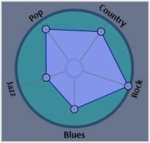We present data-driven methods for supporting musical creativity by capturing the statistics of a musical database. Specifically, we introduce a system that supports users in exploring the high-dimensional space of musical chord sequences by parameterizing the variation among chord sequences in popular music. We provide a novel user interface that exposes these learned parameters as control axes, and we propose two automatic approaches for defining these axes. One approach is based on a novel clustering procedure, the other on principal components analysis. A user study compares our approaches for defining control axes both to each other and to an approach based on manually-assigned genre labels. Results show that our automatic methods for defining control axes provide a subjectively better user experience than axes based on manual genre labeling.

Our IUI 2009 paper
Nichols E, Morris D, Basu S. Data-Driven Exploration of Musical Chord Sequences. Proceedings of Intelligent User Interfaces (IUI) 2009, February 2009.
Our Chord Transition Matrices
Our paper discusses the automatic and semi-automatic generation of chord transition matrices from databases of popular music. We have made those transition matrices available for readers here. The full set of transition matrices, along with an explanation of their format, is available in a single zip file:
nichols et al transitions.zip (opens in new tab)
The remainder of this page presents the format of these matrices; this description is identical to the one available in the zipfile.
Songsmith Compatibility
To enable experimentation and exploration with the data presented on this page, we highlight that these data files (except for the PCA-based files) are in the same format as those used for the Microsoft Research Songsmith (opens in new tab) automatic accompaniment system, which implements the HMM-based chord-generation system described in Simon et al, 2008 (opens in new tab). Songsmith uses a separate set of transition matrices which represent aggregate data from several genres that has been hand-tuned for the product; for convenience and comparison, we also include the Songsmith transition matrices here (they are included with the Songsmith product as well):
Songsmith major-key transition matrix (opens in new tab)
Songsmith minor-key transition matrix (opens in new tab)
Files
The four directories contained here correspond to the four experimental conditions described in our paper. Each directory contains the corresponding data for the four control axes used in that condition, in ASCII text files whose format is described below:
Genre (transitions matrices derived from labeled genre data):
country.txt (opens in new tab)
pop.txt (opens in new tab)
rock.txt (opens in new tab)
Genre+AbsDiff (transitions matrices derived from our AbsDiff clustering routine using genre labels as cluster seeds):
country+absdiff.txt (opens in new tab)
pop+absdiff.txt (opens in new tab)
rock+absdiff.txt (opens in new tab)
PCA (principal components analysis of all chord transitions in our database)
pca_transmodel_2.txt (opens in new tab)
pca_transmodel_3.txt (opens in new tab)
pca_transmodel_4.txt (opens in new tab)
pca_transmodel_mean.txt (opens in new tab)
Random+AbsDiff (transitions matrices derived from our AbsDiff clustering routine using random seeds):
transmodel1RandAbsDiff.txt (opens in new tab)
transmodel2RandAbsDiff.txt (opens in new tab)
transmodel3RandAbsDiff.txt (opens in new tab)
File Formats
All of the files contained here describe transition probabilities among chords. All songs were transposed into the key of C before analysis. Our dictionary of chords includes five triad types — major, minor, diminished, augmented, suspended — so we define 60 types of chords, one triad type on each of 12 possible roots, numbered as follows:
2 = C Minor
3 = C Dim
4 = C Aug
5 = C Suspended
6 = C# Major
7 = C# Minor
…
59 = B Aug
60 = B suspended
Additionally we define two special chords that represent “start of song” and “end of song”, so the probability of each chord starting and ending a song can be reflected in our data.
All probabilities are represented as _log_-probability values, so all values are negative.
For all conditions other than the PCA condition, each text file contains one transition matrix, in the following format:
logP(chord 1 appearing at the start of a song)
logP(chord 2 appearing at the start of a song)
….
logP(chord 60 appearing at the start of a song)
n n (matrix size, always 60 60)
logP(chord 1 -> chord 1)
logP(chord 1 -> chord 2)
logP(chord 1 -> chord 3)
….
logP(chord 2 -> chord 1)
logP(chord 2 -> chord 2)
…
logP(chord 60 -> chord 59)
logP(chord 60 -> chord 60)
n (# chords, always 60)
logP(chord 1 appearing at the end of a song)
logP(chord 2 appearing at the end of a song)
…
logP(chord 60 appearing at the end of a song)
The files in the ‘pca’ directory, which correspond to the PCA-based axes presented in our paper, are in the following format:
n (# chords, always 60)
P(chord 1 appearing at the start of a song)
P(chord 2 appearing at the start of a song)
….
P(chord 60 appearing at the start of a song)
n n (matrix size, always 60 60)
P(chord 1 -> chord 1)
P(chord 1 -> chord 2)
P(chord 1 -> chord 3)
….
P(chord 2 -> chord 1)
P(chord 2 -> chord 2)
…
P(chord 60 -> chord 59)
P(chord 60 -> chord 60)
n (# chords, always 60)
P(chord 1 appearing at the end of a song)
P(chord 2 appearing at the end of a song)
…
P(chord 60 appearing at the end of a song)
Note that unlike the other conditions, these are transition probabilities, not log-probabilities, so they can be combined directly without exponentiating. Also note the introduction of an additional line at the beginning of the file, specifying the variance for this component. We provide four principal components in the files pca_transmodel_[1-4].txt, and the mean — to which scaled principal component values are added to produce a transition matrix — in the file pca_transmodel_mean.txt.
People
Eric Nichols
Research Intern
Sumit Basu
Senior Principal Researcher

